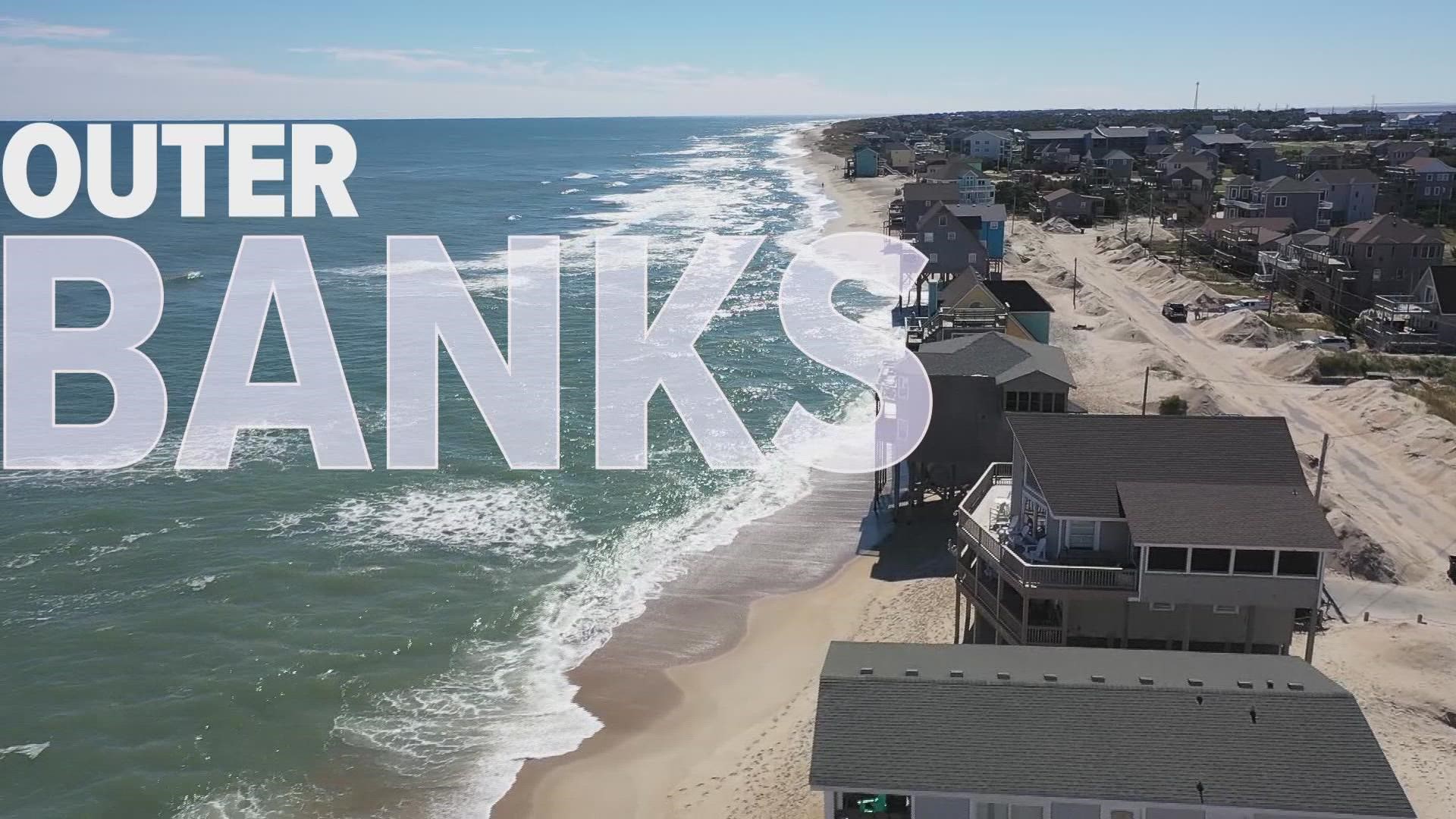NORTH CAROLINA, USA — The calming crash of ocean waves along the Outer Banks has attracted families here for generations.
"All my children grew up on these beaches, my mother used to come with my grandmother and us and my great aunt," said Pam McFaden, of Virginia.
Times have changed for McFaden but coming back here releases a flood of memories.
"They still are here," McFaden expressed. "They're in my mind here. They've been gone for years, but they're still here."
The Outer Banks are evolving as much as the lives of their visitors. The biggest change? They're shrinking.
Scientists say a rising sea level is one of the main contributors.
"We're looking at a current rate of sea level rise of about 4 to 4 ½ millimeters a year," said Reide Corbett, Executive Director of the Coastal Studies Institute and Dean of Integrated Coastal Programs at East Carolina University said.
It doesn't sound like a lot, but it is, when you look at the big picture, according to Corbett.
"We've seen basically a foot of sea level rise over the last century and we're expecting a foot of sea level rise in the next 30 years," Corbett explained.
Corbett said it's a concerning issue for the Outer Banks since much of the area is just 10 feet above sea level or less.
"If you just raise sea level a foot, you could inundate a very large area of coastal North Carolina," Corbett said.
An increase in beach erosion is the other shrinking factor.
"It's been erosive in the past, but it didn't have erosion rates as high as what they've been in the last 5 or 10 years,” Corbett said. “The erosion rate in that area has increased."
Data showed some beaches in the Outer Banks are eroding at a rate of 10-15 feet a year.
Dare County Commissioner Danny Couch knows the risks associated with beach erosion.
"Our beaches are the economy,” Couch said. "You better get on top of it or it's going to get on top of you."
Couch represents Avon Beach, an area of the Outer Banks that was in desperate need of some attention.
"The ocean was lapping at the dunes,” Couch said. “The ocean was literally pulling dune sand into the surf zone."
"We were starting to lose a lot of business because this is a prime location for parking to go to the beach," said Keith Matthews, who’s worked at the Avon Pier for 32 years.
"Used to be 3 lines of dunes here and all that's gone and it's just this one line now,” Matthews said. “It was going down into the driveway and into the parking lot."
Over the summer, the beach underwent what's called beach nourishment. The idea is simple: use giant pipes to pull in sand from the ocean to create a new beach. It's effective but it's not cheap.
"We had a $20 million+ beach nourishment project here," Couch said.
The hefty price tag paid for just two and a half miles of new beach, but county leaders said it's well worth it to keep tourists coming back.
The state's first beach nourishment occurred 45 miles up the coast, in Nags Head.
"This beach has been nourished; that'll be the third time," said Dare County Manager Bobby Outten.
He was in charge during the first nourishment in 2010. Since then, they've used increased taxes to pay for similar makeovers, up and down the coast.
Once you start, you can't stop. Leaders said you must re-do the beach at least every five years.
The technique has also been used to protect Highway 12, the only road that runs the length of the Outer Banks.
"We had to do something, DOT wasn't going to do it, so in Buxton, we did that one to protect Highway 12 and access to points south," Outten said.
Some parts of 12 have been in so much constant danger, they've built bridges around the highway.
"I would expect over time there would be more bridges to go around the hotspots," Outten said.
Even today, it's obvious the work to protect Highway 12 is ongoing.
The same can be said for Rodanthe, which experts said has some of the highest erosion rates on the east coast. The problem there, gained national attention back in May when a house collapsed into the ocean.
Dozens of houses in Rodanthe remain at risk. They're exposed to the powerful waves and experts say it's only a matter of time before they also collapse.
But there are efforts to save them.
"We're moving some houses away from the oceanfront," Couch said, referring to some houses that are being moved 45 feet inland to survive maybe another 15 years, but ultimately delaying the inevitable.
"It's not a good look for a national seashore. It's not a good look for an economy to have that kind of stuff falling into the ocean,” Couch said.
County leaders admit beach nourishment isn't the perfect solution, but it's working, for now.
Both visitors and locals appreciate the effort.
"It cost a lot of money, but we were losing a lot of money, too, so we had to have it,” Matthews said. “There was no way getting around it. We had to have it."
"It's just so nice that we still have the beach that I think it's a good thing,” McFaden said.
“It's expensive but worth it," McFaden explained.

